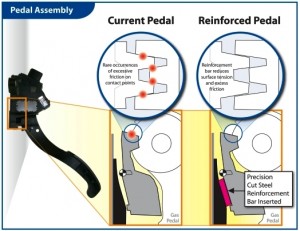Inquiries continue to increase about the controversial Toyota sticking accelerator pedal recall.
Toyota announced a fix in the early hours of this morning. These are the latest statements from Toyota about what it will do to solve the problem in North America.
When is an entirely different matter? There are millions of affected vehicles, and it is not clear how the limited number of dealers can service them in a timely manner, even if it is a 30-minute fix that just shims the pedal. The views expressed are those of Toyota and not necessarily those of the TheDetroitBureau.com. – Ken Zino, editor-in-chief.
1. What is the solution Toyota announced to fix sticking accelerator pedals?
Toyota’s engineers have developed and rigorously tested a solution that is both effective and simple. A precision-cut steel reinforcement bar will be installed into the accelerator pedal assembly, thereby eliminating the excess friction that has caused pedals to stick in rare instances.
2. What is the problem that could cause accelerators to stick and led to the recall?
The issue involves a friction device in the pedal designed to provide the proper “feel” by adding resistance and making the pedal steady and stable.
This friction device includes a “shoe” that rubs against an adjoining surface during normal pedal operation. Due to the materials used, wear and environmental conditions, these surfaces may, over time, begin to stick and release instead of operating smoothly. In some cases, friction could increase to a point that the pedal is slow to return to the idle position or, in rare cases, the pedal sticks, leaving the throttle partially open.
3. How does a steel reinforcement bar solve this problem?
The steel reinforcement bar will reduce the surface tension between the friction shoe and the adjoining surface. With this reinforcement in place, the excess friction that can cause the pedal to stick is eliminated.
4. How does Toyota know that this solution will be effective?
We have confirmed the effectiveness of the newly reinforced pedals through rigorous testing on pedal assemblies that had previously shown a tendency to stick. Nothing is more important to Toyota than the safety and satisfaction of our customers, and we have high confidence in our solution for fixing our customers’ vehicles.
5. When can I get my vehicle fixed?
We will begin contacting customers to let them know when to bring in their vehicles for the fix, and some of them will be notified as early as this week.
At Toyota, our highest priority has been to quickly and effectively address the needs of owners of affected vehicles. Parts to reinforce the pedals are already being shipped for use by dealers, and many Toyota dealers will work extended hours to complete the recall campaign as quickly and conveniently as possible — some even staying open 24 hours a day.
6. How long will it take for a dealer to repair my automobile?
The actual repair involves about 30 minutes’ work.
7. Is the repair covered by warranty? Will drivers have to pay any money out of pocket for this work?
Toyota will cover all repair costs associated with this work.
8. Does the reinforced pedal feel any different?
Drivers should not notice any change in the feel of the pedal.
9. Is my car safe to drive if it has not yet received this solution?
To be clear, the condition is rare and generally does not occur suddenly. It can occur when the pedal mechanism becomes worn and, in certain conditions, the accelerator pedal may become harder to depress, slower to return or, in the worst case, stuck in a partially depressed position.
Customers who experience an accelerator pedal that is hard to depress, slow to return or is unsmooth during operation should drive the vehicle to a safe location, shut off the engine and contact a Toyota dealer contacted for assistance
In the event that a driver experiences an accelerator pedal that sticks in a partial open throttle position or returns slowly to idle position, the vehicle can be controlled with firm and steady application of the brakes. The brakes should not be pumped repeatedly because it could deplete vacuum assist, requiring stronger brake pedal pressure. The vehicle should be driven to the nearest safe location, the engine shut off and a Toyota dealer contacted for assistance.
10. What if my vehicle is also affected by the floor mat recall? Which will be addressed first?
We are working to coordinate the pedal entrapment and the sticking pedal recalls to minimize the number of customers who will have to have two service visits.
11. What do I do if I experience a sticking accelerator pedal before my car receives the remedy? Should I bring my car to a dealer?
Customers who experience an accelerator pedal that is hard to depress, slow to return or is unsmooth during operation should drive the vehicle to a safe location, shut off the engine and contact a Toyota dealer contacted for assistance.
Otherwise, no action is required at this time unless you feel you are experiencing this condition. We will begin contacting customers to let them know when to bring in their vehicles for the fix, and some of them will be notified as early as this week.
12. Can I return my vehicle to Toyota if I purchased it in the five-day period between when the recall was announced and Toyota stopped the sale on my vehicle? What are my options?
Toyota will work with customers who have concerns about their new vehicles on a case-by-case basis.
13. Which models are affected by the sticky accelerator pedal recall/stop sale?
Toyota’s accelerator pedal recall and suspension of sales is confined to the following Toyota Division vehicles:
- Certain 2009-2010 RAV4,
- Certain 2009-2010 Corolla,
- 2009-2010 Matrix,
- 2005-2010 Avalon,
- Certain 2007-2010 Camry,
- Certain 2010 Highlander,
- 2007-2010 Tundra,
- 2008-2010 Sequoia
Highlander hybrids and Camry hybrids are not affected by this action and will remain for sale.
Further, Camry, RAV 4, Corolla and Highlander vehicles with VINs that begin with “J” are not affected.
14. What is a “VIN” and how do I find it on my automobile?
A Vehicle Identification Number (VIN) is a 17-character sequence of numbers and letters that is used by the automobile industry to uniquely identify motor vehicles. It can be viewed through the windshield on the driver’s side at the front of the dashboard.
In addition, the VIN number is also located on a sticker located the driver’s side pillar, with the tire inflation information and on the vehicle’s registration.
15. Why are mechanically similar Lexus and Scion vehicles not affected by this recall?
The recall-affected pedal is confined to one of Toyota’s suppliers. That supplier’s pedals are not used on Lexus and Scion vehicles.



The National Highway Traffic Safety Administration has also released the following “Consumer Advisory” on the Toyota controversy:
Toyota Owners Advised of Actions to Take Regarding Two Separate Recalls
The National Highway Traffic Safety Administration today informed owners of certain Toyota, Lexus and Pontiac Vibe vehicles about the actions they should take if their accelerator gets stuck or is slow to return under certain conditions.
Today’s advisory is precipitated by continued reports of consumer concern and confusion about two separate safety recalls Toyota announced over the past week involving accelerator pedals. Each recall has a different root cause – pedal entrapment and sticky pedal.
Pedal Entrapment Recall.
In October, Toyota announced the recall of 3.8 million vehicles for accelerator pedal entrapment by the floor mat. That recall was recently expanded to include another million vehicles. When an accelerator pedal is depressed to or almost to the floor, as is done during attempts to merge onto a freeway or pass another vehicle at highway speeds, it can become trapped in the fully open position by an out of position or unsecured floor mat.
Toyota has begun to notify owners of the availability of a remedy for this entrapment recall. The accelerator pedal will be reconfigured by dealers. At the same time, Toyota will develop replacement pedals for these vehicles, which will become available for some models in April 2010. Owners who first choose to have the pedal reconfigured can also receive the brand new pedal when it becomes available. New all-weather floor mats will also be provided. In addition, Toyota will install a brake override system on certain models. The brake override system would ensure the vehicle would stop if both the brake and the accelerator pedals are simultaneously applied.
Until consumers receive the remedy, it is imperative that they take out all removable floor mats on the driver’s side or ensure that any mats are properly secured. The agency has confirmed that 5 individuals, in 2 incidents, have died as a result of pedal entrapment in the recalled vehicles. Failure to follow this advice with regard to removing or securing the floor mats could lead to additional deaths and injuries. At such time as Toyota has the recall remedy for these vehicles owners will receive a letter instructing them to go to their dealer for the repair.
Toyota, Lexus and Pontiac vehicles affected by the entrapment recall are:
2007-2010 Camry
2005-2010 Avalon
2004-2009 Prius
2005-2010 Tacoma
2007-2010 Tundra
2007-2010 ES 350
2006-2010 IS 250 and IS350
2008-2010 Highlander
2009-2010 Corolla
2009-2010 Venza
2009-2010 Matrix
2009-2010 Pontiac Vibe
Sticky Pedal Recall.
In January 2010, Toyota announced the recall of 2.3 million vehicles for a problem internal to the accelerator pedal that causes it to be harder to depress, slower to return to the closed position or get stuck in some partially depressed position. Some of the vehicles included in this recall are also included in the pedal entrapment recall. Toyota has announced a remedy repair that will be available right away. The company is also having new pedals manufactured. Owners who first choose to have the pedal repaired may later receive a new pedal when it is available.
While we are aware of no deaths or injuries due to this condition, consumers should take the following steps prior to receiving the recall remedy. Owners of these vehicles should pay attention to the operation of their accelerator pedals. If their accelerator pedal is harder to depress than normal or slower to return, it may be a precursor to a stuck pedal. These vehicles should be parked and a dealer immediately notified. Should a pedal become stuck in a partially depressed condition while driving, owners should put their car in neutral, bring it to a stop and call their dealer.
Toyota, Lexus and Pontiac vehicles affected by the sticky pedal recall are:
2007-2008 Tundra
2008-2010 Sequoia
2005-2010 Avalon
2007-2010 Camry
2009-2010 Corolla
2009-2010 Matrix
2009-2010 RAV4
2010 Highlander
2009-2010 Vibe
Actions Consumers Can Take If They Cannot Stop Their Vehicle.
Regardless of the cause, if a consumer is experiencing unintended acceleration in their vehicle, they should take the following steps:
Brake firmly and steadily – do not pump the brake pedal
Shift the transmission into Neutral (for vehicles with automatic transmissions and the sport option, familiarize yourself with where Neutral is – the diagram may be misleading)
Steer to a safe location
Shut the engine off (for vehicles with keyless ignition, familiarize yourself with how to turn the vehicle off when it is moving – this may be a different action than turning the vehicle off when it is stationary).
Call your dealer or repair shop to pick up the vehicle. Do not drive it.
For more information, consumers can contact the National Highway Traffic Safety Administration’s Hotline at 888-327-4236 or the Toyota Experience Center at 1-800-331-4331 or the Lexus Customer Assistance Center at 1-800-255-3987. Information from Toyota is also posted at http://www.toyota.com and http://www.lexus.com.